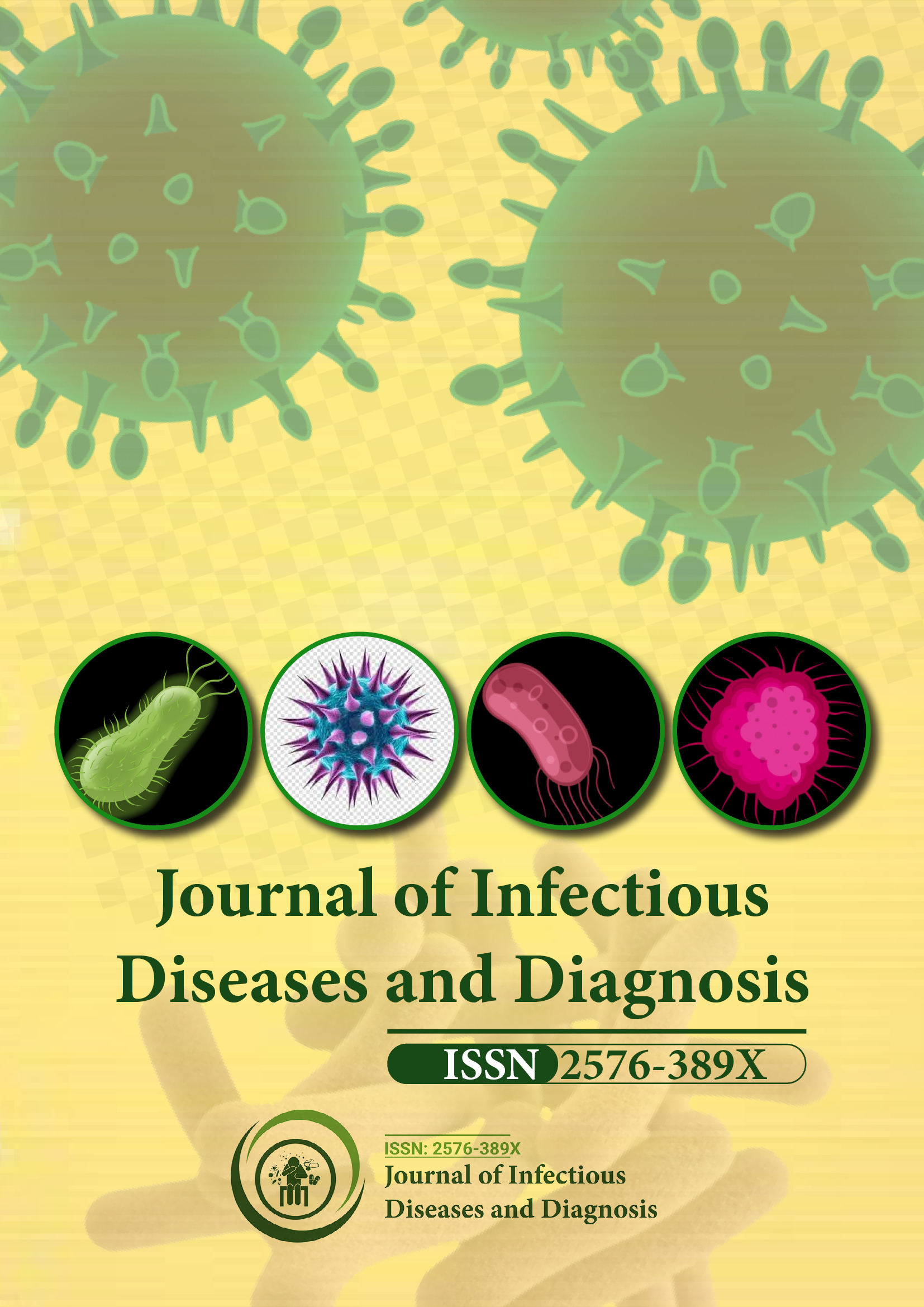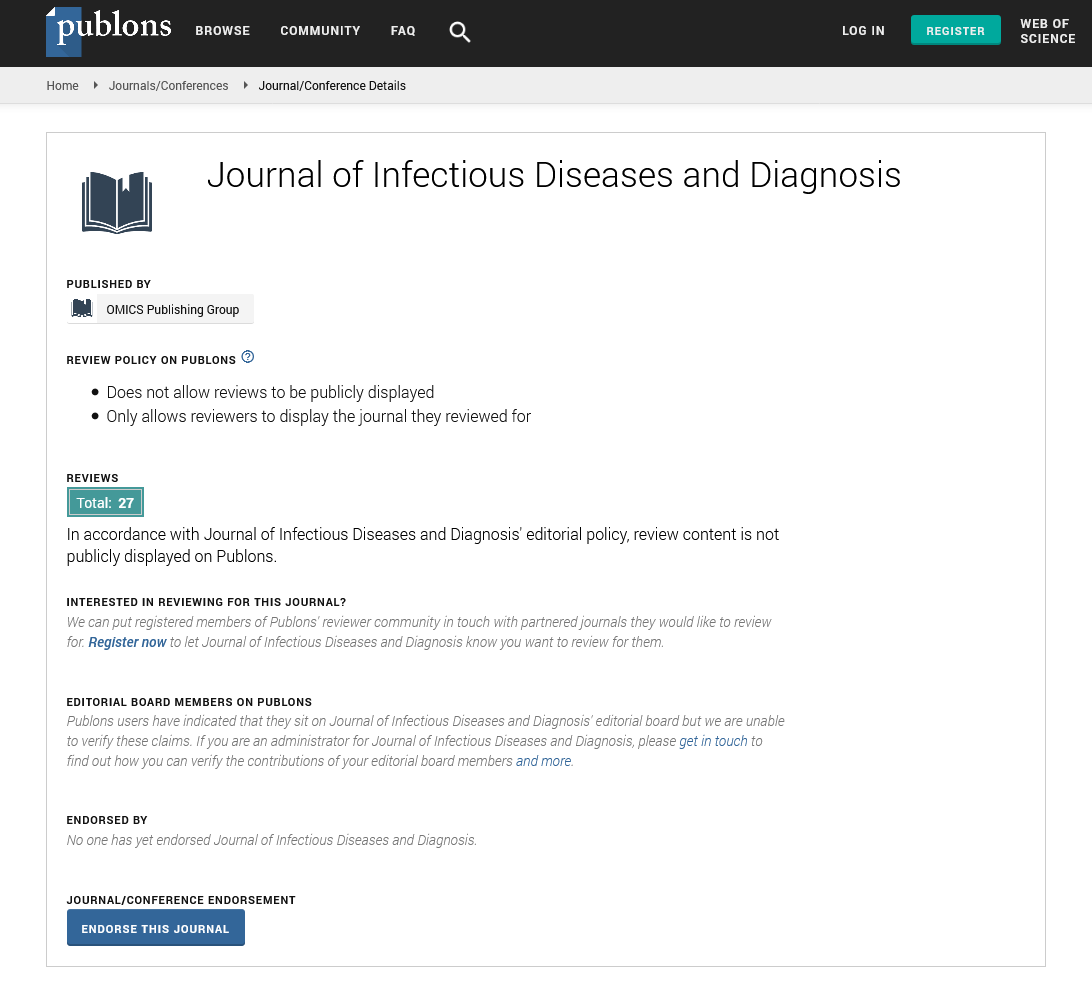Indexed In
- RefSeek
- Hamdard University
- EBSCO A-Z
- Publons
- Euro Pub
- Google Scholar
Useful Links
Share This Page
Journal Flyer

Open Access Journals
- Agri and Aquaculture
- Biochemistry
- Bioinformatics & Systems Biology
- Business & Management
- Chemistry
- Clinical Sciences
- Engineering
- Food & Nutrition
- General Science
- Genetics & Molecular Biology
- Immunology & Microbiology
- Medical Sciences
- Neuroscience & Psychology
- Nursing & Health Care
- Pharmaceutical Sciences
Commentary - (2025) Volume 10, Issue 4
Infectious Diseases Transmitted by Animals: Challenges for Global Health and Disease Prevention
Xein Chen*Received: 30-Jun-2025, Manuscript No. JIDD-25-29508; Editor assigned: 03-Jul-2025, Pre QC No. JIDD-25-29508 (PQ); Reviewed: 17-Jul-2025, QC No. JIDD-25-29508; Revised: 24-Jul-2025, Manuscript No. JIDD-25-29508 (R); Published: 31-Jul-2025, DOI: 10.35248/2576-389X.25.10.341
Description
Infectious diseases transmitted from animals to humans, commonly called zoonotic diseases, have long shaped public health and disease ecology. These illnesses arise when pathogens cross species barriers and adapt to human hosts. Animals act as reservoirs for bacteria, viruses, parasites and fungi, creating opportunities for human exposure through direct contact, consumption of animal products, or interaction with contaminated environments. The increasing overlap between human activity and animal habitats has contributed to the spread of such diseases, making them a continuing concern for healthcare systems, agriculture and environmental management.
Pathways of transmission
Transmission of animal-borne infections occurs through several mechanisms. Direct contact with infected animals, their secretions, or excretions can lead to the spread of pathogens. Indirect routes include contaminated food, water and surfaces, as well as vectors such as ticks, fleas and mosquitoes. Consumption of improperly cooked meat or unpasteurized milk can also transmit infections. Moreover, modern trade and travel amplify risks by facilitating the global spread of pathogens that were once geographically restricted. Understanding these pathways is necessary for controlling disease spread.
Examples of animal-borne infectious diseases
Several well-documented infectious diseases have animal origins. Rabies, caused by a virus transmitted primarily through bites of infected dogs or wild animals, remains a threat in many parts of the world. Without timely vaccination, rabies is almost always fatal once symptoms appear.
Avian influenza, spread by domestic and wild birds, demonstrates how animal pathogens can evolve into human health threats. Certain strains have caused severe respiratory illness and raised concerns about potential pandemics. Similarly, swine influenza has shown how viral genetic exchange within animals can give rise to new strains with human infectivity.
Bacterial diseases such as anthrax, transmitted through livestock or animal products, highlight occupational risks for farmers and workers handling hides or wool. Leptospirosis, often spread through water contaminated with the urine of infected animals, exemplifies the intersection of animal health, environment and human exposure.
Parasitic diseases also play a significant role. Toxoplasmosis, associated with cats, can pose serious risks for pregnant women and immunocompromised individuals. Echinococcosis, linked to dogs and livestock, leads to cyst formation in human organs. These examples underline the diversity of pathogens that animals can transmit to humans.
Public health implications
Zoonotic diseases account for a large share of emerging infectious diseases in humans. The economic burden is substantial, with costs arising from healthcare treatment, outbreak response, loss of livestock and trade restrictions. Beyond economic impact, these diseases disrupt communities, particularly in regions where people rely heavily on animals for food, labor, or companionship.
The interplay between humans, animals and ecosystems requires an integrated approach to address these challenges. The concept of “One Health” underscores the connection between human health, animal health and environmental sustainability. By recognizing these interdependencies, strategies can be developed to reduce the risk of cross-species pathogen transmission.
Prevention and control measures
Effective control of animal-borne diseases relies on a combination of veterinary, medical and environmental interventions. Vaccination of animals against diseases such as rabies and influenza reduces the likelihood of transmission to humans. Proper sanitation, safe food handling and pasteurization further limit exposure.
Vector control, such as reducing mosquito breeding sites or applying insecticides, helps manage diseases like West Nile virus and Rift Valley fever. Surveillance systems that track animal health provide early warning signs of potential outbreaks. For instance, monitoring bird populations can alert authorities to the circulation of avian influenza viruses before widespread human exposure occurs.
Education and awareness also play important roles. Communities benefit from understanding how daily practices, such as the handling of livestock or preparation of food, can influence infection risk. Protective measures, such as wearing gloves when handling animals or ensuring meat is thoroughly cooked, are straightforward but effective practices.
Recent challenges and emerging concerns
Rapid urbanization, deforestation and climate change are altering the distribution of animals and vectors, creating new opportunities for pathogen spread. The wildlife trade and consumption of exotic animals have been implicated in the emergence of diseases with global impact. These factors highlight the dynamic nature of zoonotic diseases and the necessity of adaptable approaches to disease prevention.
Global interconnectedness also raises concerns about rapid dissemination of infections once they appear. Air travel allows pathogens to spread across continents within hours, complicating containment measures. These realities stress the importance of cooperation across national borders, scientific disciplines and health sectors.
Conclusion
Infectious diseases caused by animals continue to present complex challenges for human health and society. Their transmission pathways are varied, encompassing direct contact, foodborne routes and vector-borne mechanisms. Examples such as rabies, avian influenza, anthrax and toxoplasmosis demonstrate the broad spectrum of threats. Effective responses depend on a comprehensive approach that includes surveillance, vaccination, education, environmental management and international collaboration. As human and animal interactions intensify, preparedness and coordinated action remain essential to reduce risks and safeguard public health.
Citation: Chen X (2025). Infectious Diseases Transmitted by Animals: Challenges for Global Health and Disease Prevention. J Infect Dis Diagn. 10:341.
Copyright: © 2025 Chen X. This is an open-access article distributed under the terms of the Creative Commons Attribution License, which permits unrestricted use, distribution and reproduction in any medium, provided the original author and source are credited.

